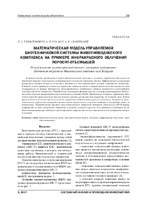| dc.contributor.author | Герасимович, Л. С. | ru |
| dc.contributor.author | Косько, А. Н. | ru |
| dc.contributor.author | Синенький, А. В. | ru |
| dc.coverage.spatial | Минск | ru |
| dc.date.accessioned | 2017-11-02T10:32:02Z | |
| dc.date.available | 2017-11-02T10:32:02Z | |
| dc.date.issued | 2017 | |
| dc.identifier.citation | Герасимович, Л. С. Математическая модель управляемой биотехнической системы животноводческого комплекса на примере инфракрасного облучения поросят-отъемышей = Mathematical model of the biotechnic system controlled by the system of animal system on the example of infrared irradiation of pig-removal / Л. С. Герасимович, А. Н. Косько, А. В. Синенький // Системный анализ и прикладная информатика. - 2017. – №3. - С. 33-39. | ru |
| dc.identifier.uri | https://rep.bntu.by/handle/data/34311 | |
| dc.description.abstract | В данной статье предлагается модель биотехнической системы и алгоритм управления облучением по поведению поросят-отъемышей с использованием технологий машинного зрения. Эффективная температура внутреннего воздуха является косвенным показателем благоприятности условий содержания животных. В данной статье выдвинута гипотеза: управление микроклиматом в животноводческом помещении должно основываться на прямых показателях благоприятности содержания. Данным показателем целесообразно считать поведение животных. Разработаны структурно функциональные схемы функционирования биотехнической системы животноводческого комплекса в нотации IDEF0. Представлен алгоритм управления облучением поросят-отъемышей по этологическому признаку расположения животных по площади пола. Задача применения технического зрения в системе управления микроклиматом ранее не решалась. Алгоритмы автоматического управления электротехнологическими процессами в сельском хозяйстве в литературе ранее не встречались. Разработанный принцип интеллектуального управления позволяет оптимально обеспечивать комфортные условия содержания животных в режиме реального времени. Результаты исследования могут быть использованы при создании и проектировании современных систем автоматического управления микроклиматом. | ru |
| dc.language.iso | ru | ru |
| dc.publisher | БНТУ | ru |
| dc.subject | Биотехническая система | ru |
| dc.subject | Математическая модель | ru |
| dc.subject | Этология | ru |
| dc.subject | Инфракрасное облучение | ru |
| dc.subject | Поросята-отъемыши | ru |
| dc.subject | Biotechnical system | en |
| dc.subject | Mathematical model | en |
| dc.subject | Ethology | en |
| dc.subject | Infrared radiation | en |
| dc.subject | Piglets | en |
| dc.title | Математическая модель управляемой биотехнической системы животноводческого комплекса на примере инфракрасного облучения поросят-отъемышей | ru |
| dc.title.alternative | Mathematical model of the biotechnic system controlled by the system of animal system on the example of infrared irradiation of pig-removal | en |
| dc.type | Article | ru |
| dc.relation.journal | Системный анализ и прикладная информатика | ru |
| local.description.annotation | This article proposes a model biotechnical system and exposure control algorithm on the behavior of piglets using machine vision technology. The effective temperature of the indoor air is an indirect indicator of the favourable conditions for keeping animals. In this article, a hypothesis has been put forward: the management of the microclimate in the cattle-breeding premises should be based on direct indicators of the favourableness of the content. This indicator is appropriate to consider the behaviour of animals. Structurally functional schemes for the functioning of the biotechnical system of the cattle-breeding complex have been developed in the IDEF0 notation. An algorithm for controlling the irradiation of piglets and weaners based on the ethological character of the location of animals across the floor area is presented. This problem was not solved before. Algorithms for automatic control of electro technological processes in agriculture have not been encountered in the literature before. The developed principle of intelligent control allows optimal provision of comfortable conditions for keeping animals in real time. The results can be used to create and design of modern automatic climate control systems in livestock. | en |

